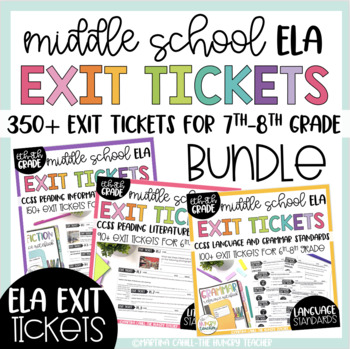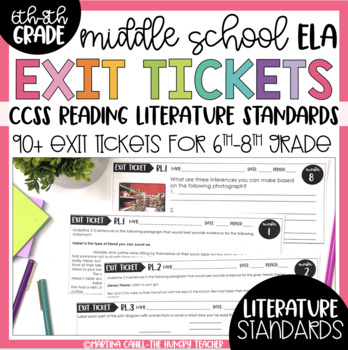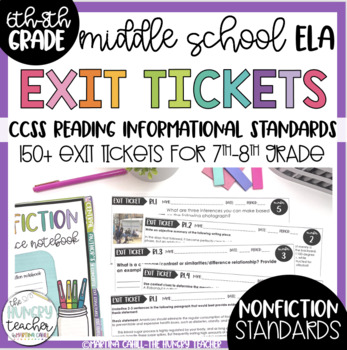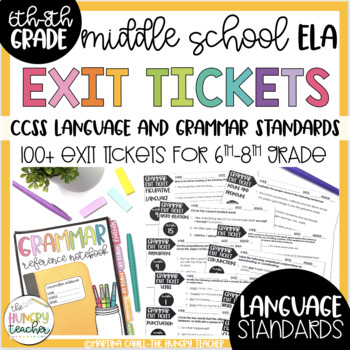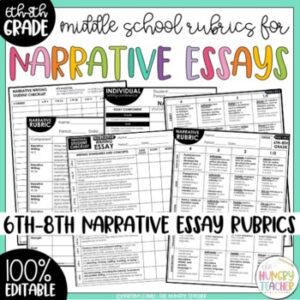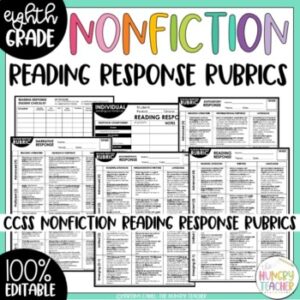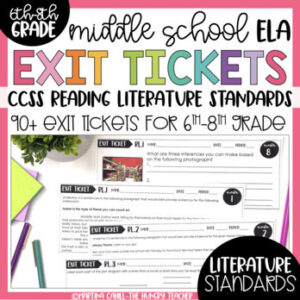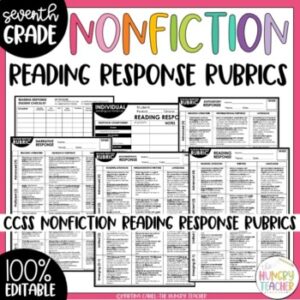Description
Download a preview <<HERE>>
This bundles resource has 100 grammar and language exit tickets or quizzes, 85 literature exit tickets or quizzes, and 150+ nonfiction exit tickets or quizzes.
-
The grammar and language exit tickets resource assesses students’ mastery of concepts like sentences, clauses, figurative language, punctuation, nouns, pronouns, conjunctions, verbs, word relations, adjectives, spelling, and prepositions.
-
The literature reading exit tickets resource assesses students’ mastery of concepts like theme, point of view, providing text evidence, inferring, determining the main idea, characterization, literary conflict, literary devices, plot, and more!
-
The nonfiction reading exit tickets resource assesses students’ mastery of concepts like central idea, writing objective summaries, providing text evidence, inferring, determining the main idea, nonfiction text structures, context clues for vocabulary, and more!
-
102+ Grammar and Language Exit Tickets with three exit tickets per page
-
80+ Literature Exit Tickets
-
150+ Non-Fiction/Informational Reading Exit Tickets
-
Answer keys for EVERY single exit ticket
-
6th, 7th, and 8th Grade Common Core Language, Literature, and Nonfiction Standards
-
3-20 exit tickets for each CCSS language standard
-
Providing text evidence
-
Inferences
-
Explicitly stated evidence
-
Theme
-
Main Idea
-
Character Traits
-
Literature summaries
-
How setting reveals character traits
-
How dialogue reveals character traits
-
Internal conflict
-
External Conflict
-
The four types of conflict
-
Characters: antagonist, protagonist, flat character, round characters, static character, dynamic character, sympathetic character, minor character
-
Literary Devices: flashback, flash-forward, cliff-hanger, suspense
-
Elements of plot: Exposition, inciting incident, rising action, climax, falling action, resolution
-
Word connotation and denotation
-
Context Clues
-
Figurative language: personification, allusion, alliteration, metaphor, simile, irony, idiom, hyperbole.
-
Poem analysis
-
Poetry terms: Rhyme, meter, rhythm, foot, verse, stanza, refrain, couplet, quatrain, octave, internal rhyme, end rhyme, partial rhyme, complete rhyme.
-
Assonance
-
Consonance
-
Mood
-
Tone
-
Point of View: First-person, second person, third person
-
Comparing movie adaptations to books
-
Comparing fictional and historical texts
-
Comparing how novels compare to myths, Bible stories
-
Genres: fiction, non-fiction, biography, autobiography, realistic fiction, dystopian, science fiction, fantasy, historical fiction.
-
Providing textual evidence
-
Thesis statements
-
Inferences
-
Explicitly stated evidence
-
Citing Textual evidence that strongly supports analysis
-
Citing Textual evidence that strongly supports inferences
-
Objective summaries
-
Central idea
-
Central idea developed over the course of the text
-
Cause and Effect text relationships
-
Problem and Solution text relationships
-
Similarities and Differences in text relationships
-
Sequence of events text relationships
-
Context clues to determine word meanings
-
Figurative language and impact on the text: personification, allusion, alliteration, metaphor, simile, irony, idiom, hyperbole.
-
Assonance
-
Consonance
-
Mood
-
Tone
-
How sections of the text contribute to the text as a whole
-
Analyzing how authors develop and organize the text
-
Author’s purpose: persuade, inform, entertain, explain, describe
-
Analyzing author’s distinguishing their point of view from others
-
Acknowledging and responding to conflicting evidence or viewpoints
-
Compare and contrast a text to an audio, video, or multimedia version of the text, analyzing each medium’s portrayal of the subject
-
Evaluate the advantages and disadvantages of using different mediums
-
Trace and evaluate the argument and specific claims in a text
-
Analyze how two or more authors writing about the same topic shape their presentations of key information
-
Genres: fiction, non-fiction, biography, autobiography, realistic fiction, dystopian, science fiction, fantasy, historical fiction
-
Sentences (9 tickets)
-
Clauses (3 tickets)
-
Figurative Language (10 tickets)
-
Punctuation (17 tickets)
-
Nouns and Pronouns (12 tickets)
-
Conjunctions (3 tickets)
-
Verbs (15 tickets)
-
Word Relations (20 tickets)
-
Adjectives (6 tickets)
-
Spelling (2 tickets)
-
Prepositions (4 tickets)
-
Parts of Speech
-
Simple Sentences
-
Complex Sentences
-
Compound Sentences
-
Compound-Complex Sentences
-
Independent and Dependent Clauses
-
Figurative Language: Hyperboles
-
Types of Phrases
-
Absolute Phrases
-
Appositive Phrases
-
Gerund Phrases
-
Infinite Phrases
-
Noun Phrases
-
Participle Phrases
-
Prepositional Phrase
-
Colons and Semicolons
-
Types of Pronouns
-
Possessive Pronouns
-
Reflexive Pronouns
-
Reciprocal Pronouns
-
Demonstrative Pronouns
-
Interrogative Pronouns
-
Indefinite Pronouns
-
Subordinating Conjunctions
-
Coordinating Conjunctions
-
Using Quotation Marks Correctly
-
Verb Moods
-
Indicative Verb Mood
-
Imperative Verb Mood
-
Interrogative Verb Mood
-
Conditional Verb Mood
-
Subjunctive Verb Mood
-
Figurative Language: Personification
-
Common Prefixes and their Meanings
-
Using Context Clues to determine word meanings
-
Connotation and Denotation
-
Infinitive Verbs
-
Present Participle Verbs
-
Past Participle Verbs
-
Past Tense Verbs
-
Common and Proper Nouns
-
Common Homophones
-
Intensive Pronouns
-
Vague Pronouns
-
Direct Objects
-
Indirect Objects
-
Object of the Preposition
-
Figurative Language: Metaphor
-
Figurative Language: Simile
-
Punctuation Nonrestrictive Elements
-
Author Style and Tone
-
Comparative Adjective
-
Superlative Adjectives
-
Benefits of using the four different types of sentence structure (variety)
-
Proper noun Rules
-
Dangling Modifier Rules
-
Expressing Ideas Precisely and eliminating wordiness and redundancy
-
Plural Noun Rules
-
Verbals
-
Gerunds
-
Infinitives
-
Past and Present Participle
-
Abstract Nouns
-
Concrete Nouns
-
Punctuating and Capitalizing Titles of Works
-
Subjects and Predicates
-
Simple Subjects and Predicates
-
Compound Subjects and Predicates
-
Verb Tenses (12 Different Verb Tenses)
-
Action Verbs
-
Linking Verbs
-
Helping Verbs
-
Figurative Language: Allusion
-
Rules for Using Numbers in English
-
Rules for Using Apostrophes in English
-
Rules for Using Commas in English
-
Prepositions and Prepositional Phrases
-
Direct Objects
-
Indirect Objects
-
Object of the Preposition
-
Commonly Confused Words
-
Situational Irony
-
Dramatic Irony
-
Verbal Irony
-
Active Verbs
-
Passive Verbs
-
Imperative Sentences
-
Exclamatory Sentences
-
Interrogative Sentences
-
Declarative Sentences
-
Descriptive Adjective
-
Quantitative Adjectives
-
Demonstrative Adjectives
-
Possessive Adjectives
-
Distributive Adjectives
-
Interrogative Adjectives
-
Articles (Adjectives)
-
Antonyms
-
Synonyms
-
Figurative Language: Idioms
-
Differences between Who and Whom
You may also like…
